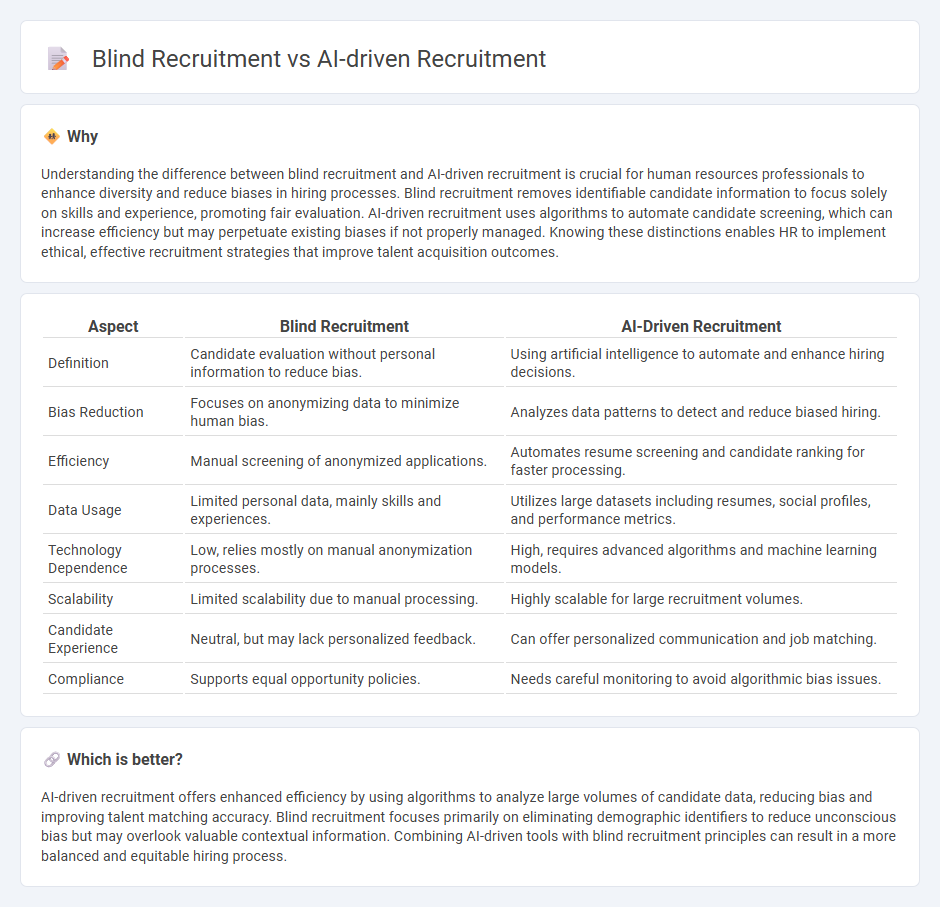
Blind recruitment eliminates biases by anonymizing candidate information, focusing solely on skills and experience to promote diversity and fairness in hiring. AI-driven recruitment utilizes advanced algorithms to analyze vast datasets, streamline candidate matching, and improve efficiency while potentially reducing human error. Explore the benefits and challenges of these innovative hiring approaches to enhance your recruitment strategy.
Why it is important
Understanding the difference between blind recruitment and AI-driven recruitment is crucial for human resources professionals to enhance diversity and reduce biases in hiring processes. Blind recruitment removes identifiable candidate information to focus solely on skills and experience, promoting fair evaluation. AI-driven recruitment uses algorithms to automate candidate screening, which can increase efficiency but may perpetuate existing biases if not properly managed. Knowing these distinctions enables HR to implement ethical, effective recruitment strategies that improve talent acquisition outcomes.
Comparison Table
| Aspect | Blind Recruitment | AI-Driven Recruitment |
|---|---|---|
| Definition | Candidate evaluation without personal information to reduce bias. | Using artificial intelligence to automate and enhance hiring decisions. |
| Bias Reduction | Focuses on anonymizing data to minimize human bias. | Analyzes data patterns to detect and reduce biased hiring. |
| Efficiency | Manual screening of anonymized applications. | Automates resume screening and candidate ranking for faster processing. |
| Data Usage | Limited personal data, mainly skills and experiences. | Utilizes large datasets including resumes, social profiles, and performance metrics. |
| Technology Dependence | Low, relies mostly on manual anonymization processes. | High, requires advanced algorithms and machine learning models. |
| Scalability | Limited scalability due to manual processing. | Highly scalable for large recruitment volumes. |
| Candidate Experience | Neutral, but may lack personalized feedback. | Can offer personalized communication and job matching. |
| Compliance | Supports equal opportunity policies. | Needs careful monitoring to avoid algorithmic bias issues. |
Which is better?
AI-driven recruitment offers enhanced efficiency by using algorithms to analyze large volumes of candidate data, reducing bias and improving talent matching accuracy. Blind recruitment focuses primarily on eliminating demographic identifiers to reduce unconscious bias but may overlook valuable contextual information. Combining AI-driven tools with blind recruitment principles can result in a more balanced and equitable hiring process.
Connection
Blind recruitment utilizes AI-driven algorithms to remove personal identifiers such as names, gender, and ethnicity from applications, promoting unbiased hiring decisions. AI-driven recruitment enhances blind recruitment by analyzing candidate skills, experience, and qualifications more objectively, reducing unconscious bias and improving diversity. The integration of AI in blind recruitment streamlines candidate evaluation, increases fairness, and supports inclusive talent acquisition in Human Resources.
Key Terms
Algorithmic Screening
AI-driven recruitment leverages advanced algorithmic screening to analyze candidate data, improving efficiency and reducing human bias by evaluating resumes, work history, and social signals. In contrast, blind recruitment removes identifiable information like names and addresses but may overlook nuanced candidate insights that AI algorithms capture. Explore how integrating algorithmic screening enhances objectivity and talent matching in modern hiring processes.
Unconscious Bias
AI-driven recruitment leverages machine learning algorithms to analyze candidate data, reducing human errors and minimizing unconscious bias in hiring decisions. In contrast, blind recruitment removes identifiable information to obscure personal characteristics, but it may overlook nuanced candidate qualities that AI can assess. Explore how integrating AI with unbiased techniques can enhance fair hiring outcomes and reduce workplace discrimination.
Candidate Anonymization
AI-driven recruitment leverages machine learning algorithms to analyze vast datasets, enhancing candidate matching while reducing human biases through candidate anonymization techniques. Blind recruitment emphasizes removing identifiable information such as names, gender, and education background to focus solely on skills and experience, promoting diversity and fairness in hiring. Explore the latest advancements and impacts of AI-powered candidate anonymization methods to transform your recruitment process.
Source and External Links
AI in Recruiting: Smarter Hiring Starts Here - AI-driven recruitment uses AI-powered tools to streamline talent sourcing, screening, and workflow automation, helping companies hire faster and more fairly while augmenting human recruiters rather than replacing them.
AI for Recruiting: A Definitive Guide to Talent Acquisition in ... - AI in recruitment enhances automation of repetitive tasks like resume screening and interview scheduling, and improves personalization of candidate engagement and communication to boost productivity and candidate experience.
How AI is Transforming Recruitment in 2025 - AI reshapes recruitment by efficiently sourcing and screening candidates with data-driven precision, reducing time-to-hire while freeing recruiters for strategic activities that require human empathy and culture-fit evaluation.
 dowidth.com
dowidth.com